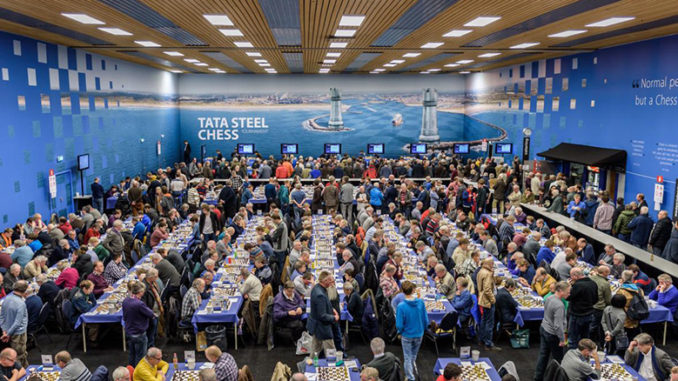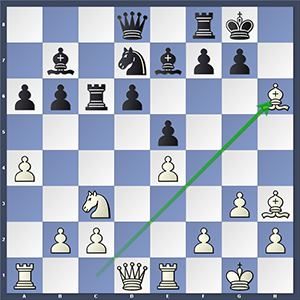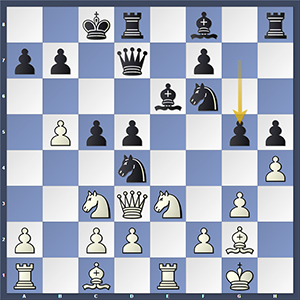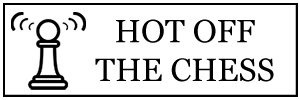
After the ‘Chess on Tour’ day, for round 5 in Rotterdam, it was business as usual when the Tata Steel Chess Tournament 2017 returned to Wijk aan Zee for round 6 on Friday 20th January. There was a new leader, Wesley So, who had taken over from Pavel Eljanov following the victory of the former and the defeat of the latter in round 5. But could he keep up the momentum?
Well, not if Baskaran Adhiban had anything to do with it. Adhiban had stunned Sergey Karjakin in round five, not only beating him with the Black pieces, but also with the French Defence, which he had apparently never played before. In this round, he pushed the boat out again, playing the King’s Gambit of all things. The Indian’s bottle is undoubtable, but was he pushing his luck?
Well in a way, (there is a reason that the King’s Gambit is rarely seen these days), but Baskaran actually did quite well and held some advantage early on. A couple of slow moves cost him, however, castling on move 16, when there was the more positive Nc5 available. This could well have led to the exchange of Queens, 16…Qb5 17.Qxb5 cxb5 and then 18.Nxb7 leaves White with a good situation.
As it was, Black was allowed to achieve a comfortable equality, especially after White’s 18.Bd4(?) which was rather wasteful and gave Black an easy target with 18…c5. So then claimed the e-pawn, which levelled the material and together with the bishop pair, sitting beautifully in an open position, he will have been very happy. By contrast, White was quite passive. In the end, however, Adhiban was never in danger in the game, even with his 31.Rf3, which busted up his Kingside somewhat. Black was undoubtedly better after this, but So did not push things and the game was drawn.
Dutch Grandmaster, Anish Giri, ended his drawing streak in this round and notched up a full point. He played Ian Nepomniachtchi of Russia and would give the home spectators something to cheer about. Nepomniachtchi took to the Najdorf in answer to Giri’s 1.e4 and after White’s 15.Re1 (which appears to be a novelty) got in to all kinds of trouble. Black’s 15…h6 may well have been an early indicator that he was not entirely comfortable with the situation, there were other moves available. Furthermore, the move actually gave Black a weakness. There followed, 16.Bh3, which actually set up a trick, that Nepomniachtchi seemed to miss completely. After 16…Rc6, Giri struck with 17.Bxh6(!!) picking up a free pawn.

As can be seen in the diagram, should Black capture the bishop on h6, with 17…gxh6, White plays 18.Qg4+ followed by the capture of the inadequately protected black knight on d7. And this is actually what happened (there was nothing better for Black it has to be said), leaving Giri sitting extremely pretty. Anish then demonstrated that he is no draw King and when the door is opened, he can attack like the best of them, his 25.f4 and 26.e5 were fine examples of that, a passed pawn was added to his arsenal and he was soon totally winning. With Nepomniachtchi already up against it, the final blow came with 32.Bxa6(!!) and Black is actually in zugzwang. Destined to lose his one remaining bishop in order to stop White from Queening the e-pawn, the Russian resigned.
I know that Anish Giri gets a bit of stick from the chess public, for the amount of draws he makes and this is something that he is obviously aware of himself. There was a great crack from him in the press room after the game, when invited up to the chess.com studio to talk with Yasser Seirawan. He responded, “A once in a lifetime experience, you mean?” to roars of laughter. Seriously, though all credit is due to him for this game, he played it beautifully.
The other win of the round came in Rapport-Wei, when the latter scored with his beloved Petroff. One has to give credit to Richard Rapport, who often brings such a fresh way of opening the game and getting his pieces out. I have heard it said that some of his opening setups resemble Fischer random positions, and that is very true! In this game he did his best to ‘untame’ the Petroff and get his opponent out of his comfort zone. And to some extent this worked, with a position that was by no means the usual kind of simplified Petroff that we are so used to seeing. Infact, it produced totally the opposite, a sharp position where mistakes were very possible. And mistakes there were, the first from Wei with his 15…g5(?).

Here, Black fails to take into consideration the vulnerability of his Nf6 and d5-pawn and White can illustrate this perfectly with 16.hxg5(!) which forces the knight to move and desert d5, towards which White’s forces are nicely concentrated. After 16…Ng4 (…Ne4 17.Nxe4 dxe4 18.Qxe4 winning) 17.Ncxd5 Ne5 (…Bxd5 18.Nxd5 winning) 18.Qe4 Bxd5 19.Nxd5 Re8 20.Kf1, White is two pawns to the good and with a very nice position.
Rapport chose 16.b6, which is a good positional move, throwing yet another danger for Black into the works. White threatens bxa7, which forces …Kc7 in order to stop White Queening. With hxg5 also looming and the vulnerability of the d5-square this is no small thing. In short, White had an immense position and after 16…a6 (…axb6 17.hxg5 and after the knight moves, Ncxd5 winning) 17.hxg5 Ng4 18.Ncxd5 was probably verging on winning. And after Black’s 18…h4(??) 19.Nxg4 Bxd5 20.Nf6(!!) was extremely strong.
However, here is where Rapport sadly let his hard work go to waste, opting for the much less dangerous 19.Nc7(?) instead. This allowed Black’s counter of 19…h3 and after White’s 20.Bxb7+(?? 20.Nxg4 was necessary, leading to equality with best play) …Kxb7, White’s position had spontaneously combusted and Black was better. Soon, Rapport was losing heavily, with a mere four pawns in return for two pieces and unable to make anything of his b-pawn. His only hope was to force a draw via perpetual or repetition, but Wei managed to hide his King and consolidate. There was nothing left for White but to resign.
Elsewhere, the games were drawn. First to finish was Aronian-Carlsen, which was not highly unexpected. The players got into a Slav Defence, and the game followed Q. L. Lu-Vallejo Pons, from the FIDE World Cup 2013, but White deviated quickly with 15.Qb6. 15.Nc6 had been played in the previous game, which was drawn and this one didn’t prove more exciting to be honest.
The game was fairly quiet, with everything taking place on the Queenside, but this was resolved fairly quickly and the players split the point. Nothing about this game was really surprising to me. Likewise in Eljanov-Karjakin, especially when this turned into a Berlin. In saying that, White did have the best of things and possibly some chances, but it was not a big shock when they repeated and split the point.
The other two draws were more lengthy affairs, Loek van Wely and Dmitry Andreikin in a 60-mover. In a Queen’s Gambit Declined, White built up a good position and definitely had chances, but didn’t make the most of them, unfortunately for him. However, the Dutchman can take solace in stopping his losing streak and getting at least something on the scoreboard.
The Closed Ruy of Harikrishna-Wojtaszek lasted even longer, 67-moves infact. White was firmly in command, confidently trading piece for three pawns and then picking up another. However, Harikrishna went awry in the endgame and allowed Wojtaszek to throw enough spanners in the works to save the point.
All of this meant that Wesley So retained the lead of the tournament with 4.5/6. Magnus Carlsen and Pavel Eljanov are just behind him, however.
Masters Group Standings after Round 6.
- So — 4.5
- Carlsen, Eljanov — 4.0
- Aronian, Giri, Wei — 3.5
- Harikrishna, Andreikin, Karjakin, Wojtaszek — 3.0
- Adhiban — 2.5
- Nepomniachtchi — 2.0
- Rapport — 1.5
- Van Wely — 1.0
Masters Group Round 7, Saturday 21st January, 13:30 local time.
Karjakin – Aronian
So – Eljanov
Wojtaszek – Adhiban
Andreikin – Harikrishna
Wei – Van Wely
Nepomniachtchi – Rapport
Carlsen – Giri.
The Challengers Group was a bloody affair once again, with all but one of the games being decided. Of most note was Gawain Jones’ defeat of group leader, Markus Ragger. The British Grandmaster has now won three games on the trot and joins Ragger in the lead on 4.5/6.
Challengers Group Standings after Round 6.
- Ragger, Jones — 4.5
- Smirin, Lu — 4.0
- Hansen, Xiong, Grandelius — 3.5
- l’Ami, Tari — 3.0
- Dobrov, Bok — 2.5
- van Foreest — 2.0
- Lei — 1.0
- Guramishvili — 0.5
Challengers Group Round 7, Saturday 21st January, 13:30 local time.
Tari – Grandelius
Bok – Smirin
Ragger – Guramishvili
van Foreest – Jones
l’Ami – Lu
Xiong – Dobrov
Tingjie – Hansen.
